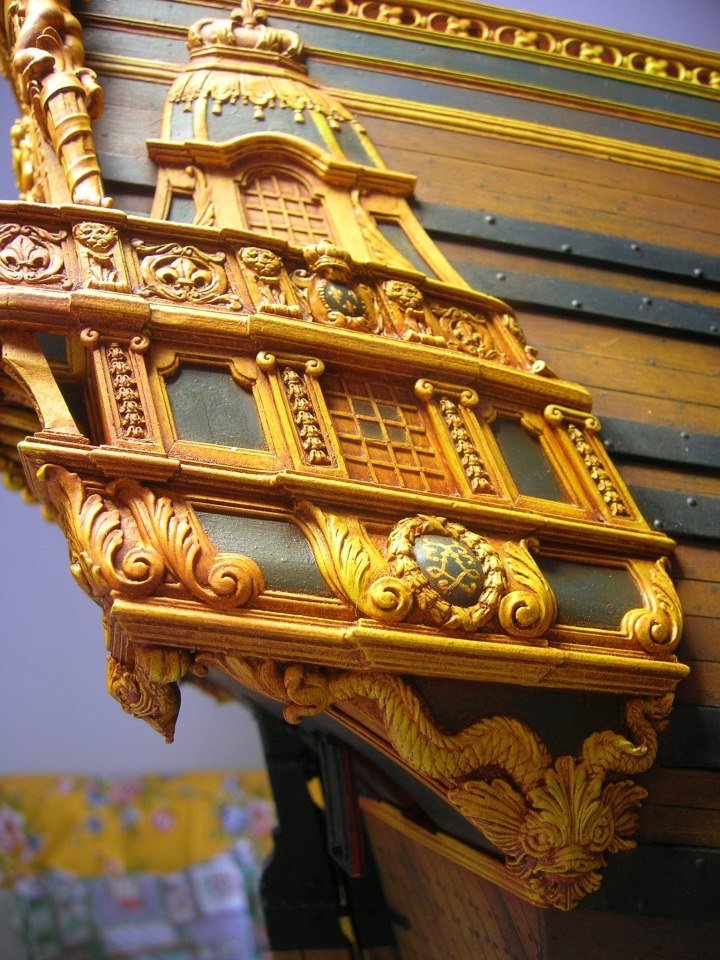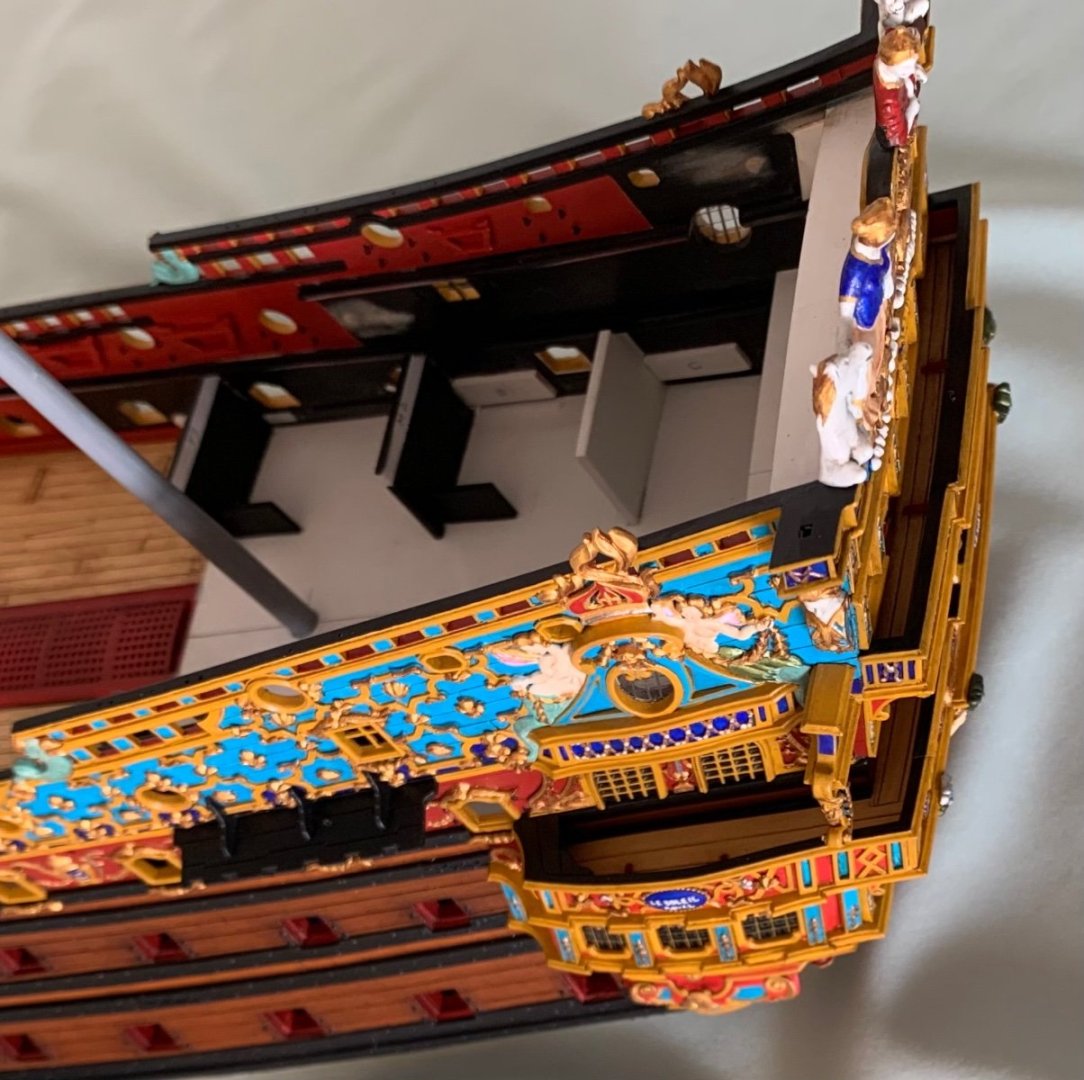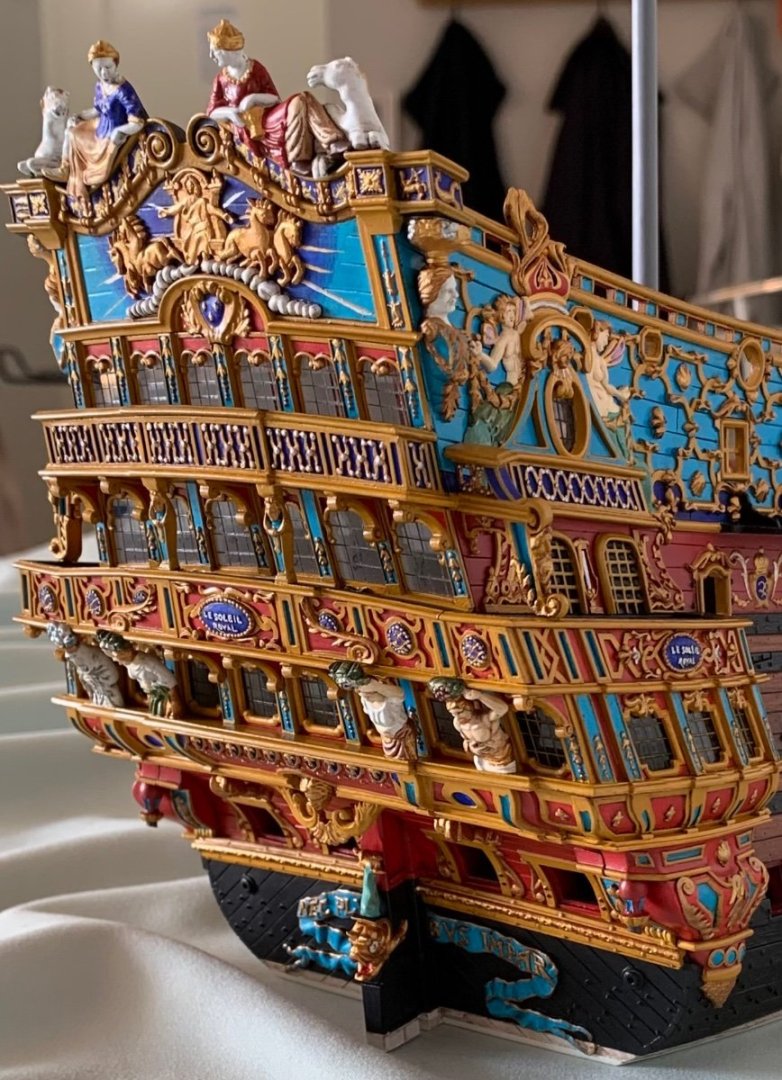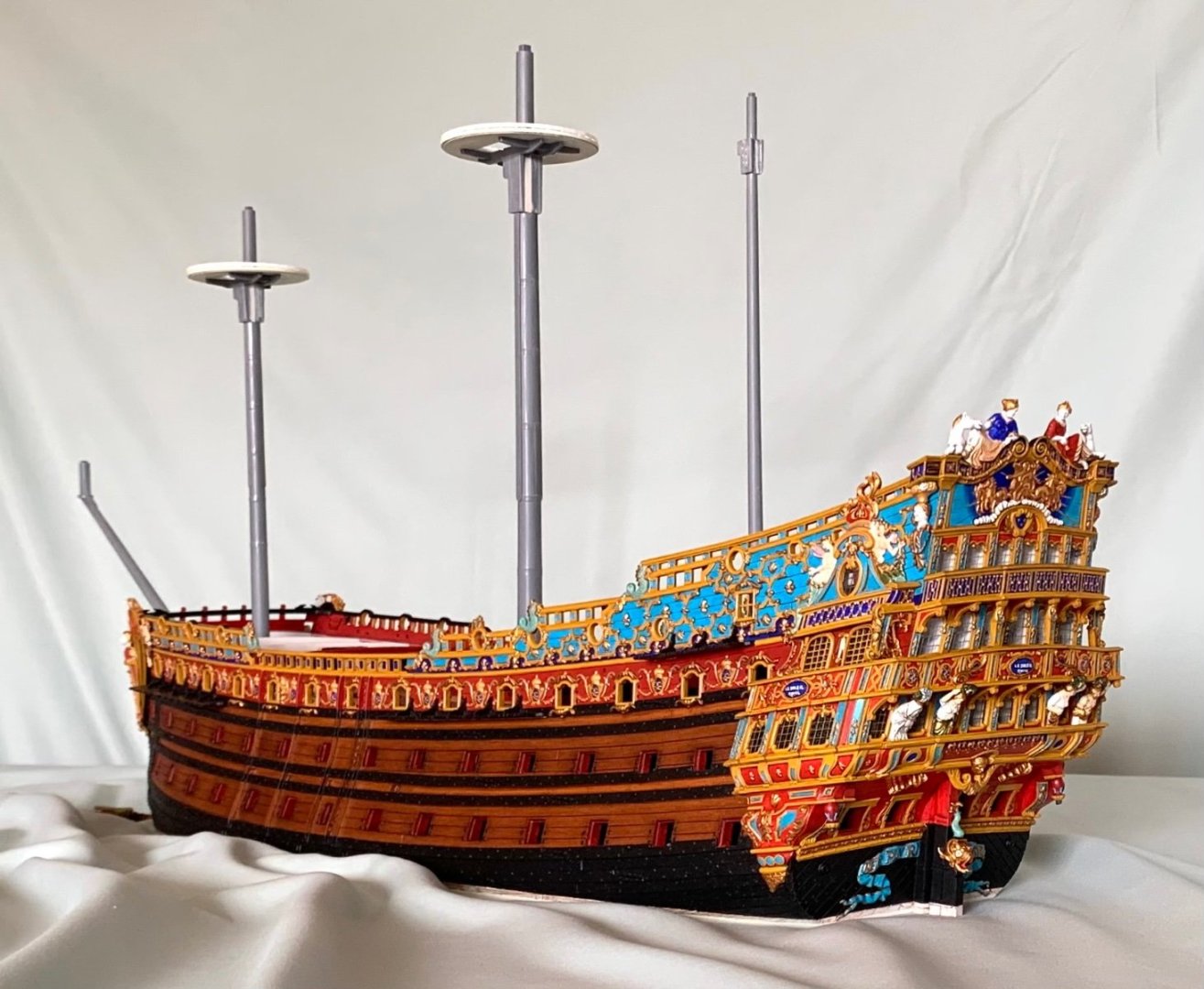-
Posts
2,949 -
Joined
-
Last visited
Content Type
Profiles
Forums
Gallery
Events
Everything posted by Hubac's Historian
-
It seems logical to me that the lower gallery tier would be one continuously open space; at the aft end, there will be the functional seat of ease, while on the forward end, there would be a removable false window panel concealing the gallery gunport. I also think it likely that, within the gallery, the port would be equipped with a water-tight port lid. In the event that the gallery is heavily damaged, or washed away in a rough seaway, there would still be a barrier for keeping sea water out of the hull. The entry doorway to the gallery would have a door, for the same preventative purpose, so the gun port would have a port lid. So, the question then becomes a matter of display; do you want to show that there is a gunport hidden behind a false window panel, or do you want to present the un-interrupted facade of the gallery, and presume that the viewer understands there would be concealed gun ports within the gallery? It seems unlikely to me that the French would disrupt the continuity of their design with a missing panel in the gallery. I suspect that this modeler was indicating in a stylized way that there is an active cannon port behind this middle false window panel: Although, it would make more sense for that port to be placed in the panel space to the right, as you are indicating with Le Fulminant.
-
Nice cliff-hanger on the Velez Malaga tale of intrigue! I like your margin plank solution to the deck problem. I have also, lately, become interested in certain instances where modelers eschew priming; in this instance, the color of the moulded plastic is actually an ally to the desired effect. The decks really do look brilliant. I’m looking forward to the next installment in this serial build log - clog, leak and spit away!
- 80 replies
-
- Soleil Royal
- Ship-of-the-line
-
(and 2 more)
Tagged with:
-
In English, the wales are the double bands of thicker timber that follow the upward sheer of the ship, often crossing over the aft-most ports. The French call these timbers the precients. The “quarter galleries” encompass the entirety of the lightly framed side structures, which include the functional seats of ease - usually on the middle deck level, as well as the upper and lower finishing. The French call these structures, bouteille for their resemblance to perfume bottles.
-
This is my current project. It is an extreme kit bash of the Heller Soleil Royal. I have reconstructed the entire ornamental program from scratch, in styrene. Yes, it will ultimately be a waterline diorama. There are a few of us doing these transformation projects on the site. This is the reason that your Fulminant project is so interesting to me. I am very interested in broadening the scope of modeling subjects, by developing a better understanding of this less well documented period in French naval architecture.
-
By the time of the refit, in 1688, First rates would have been single-reefed on the fore and mainsail, and double-reefed on tue topsails. Aesthitically, I might strike a balance between .4, which seems a little short, and .5.
- 1,503 replies
-
- Le Soleil Royal
- Heller
-
(and 1 more)
Tagged with:
-
I am hoping to have him print lanterns for me.
- 80 replies
-
- Soleil Royal
- Ship-of-the-line
-
(and 2 more)
Tagged with:
-
This guy, Kris from Poland is doing exactly that:
- 80 replies
-
- Soleil Royal
- Ship-of-the-line
-
(and 2 more)
Tagged with:
-
I, if I may be so bold, will judge that this was a solid move. One issue with the Tanneron model is that the forward sheer of the lower wales is a little aggressive. Heller copied this even more aggressively. lowering the head a little, even if it means submerging the gammoning a little, helps to minimize this exaggeration. Well done! On a separate note, some (myself included), have taken issue with this or that assertion from Jean Claude Lemineur. However, he is the only one to delve so deeply into the murky waters of 1680 and beyond. Over the years, and particularly in my early state of broad ignorance, he was always a very gracious correspondent. Everything that he does, and John does and other builders do, pushes the conversation forward, ever so incrementally. Let’s all keep going, sharing, discussing, and trying to put the puzzle together. My hope is to build a broad enough basis of research so that one could reasonably build a model of La Royal Therese - an example of which that still does not exist on any public forum that I know of.
- 80 replies
-
- Soleil Royal
- Ship-of-the-line
-
(and 2 more)
Tagged with:
-
I can definitely relate to the “middle-class wage earner” statement, but your job sounds a lot more interesting than mine.
- 80 replies
-
- Soleil Royal
- Ship-of-the-line
-
(and 2 more)
Tagged with:
-
It all looks as though it grew there like the crystalline perfection of some fantastic geode.
-
Bill, it’s difficult to get a sense of the different t’gallant heights without a perspective shot of the entire rig.
- 1,503 replies
-
- Le Soleil Royal
- Heller
-
(and 1 more)
Tagged with:
-
The rig all looks neat and taught, Bill!
- 1,503 replies
-
- Le Soleil Royal
- Heller
-
(and 1 more)
Tagged with:
-
Correct, they are both full three deckers, and were classified as First-Rates. When these ships were first constructed in the 1690’s, they were overloaded with the number of guns in such a way that adversely affected their handling, and subsequently their armament was reduced. When I say that they are the origin point for the 74, what I mean is that this was the first attempt to really standardize efficient fire-power and handling. Ultimately, this tendency culminates in the 74, but there would certainly have been more direct corollaries in the 18th Century.
-
I also want to say that your connection of Versailles to the coloration and architecture of SR’s stern is right-on. For years, I puzzled over just what all of these different color choices were actually trying to represent. I thought the bronze sculptures were maybe to indicate ornamental carvings that were preserved from before the refit. With your parallel color examples to art within Versailles, you have made the probable intent very clear.
- 80 replies
-
- Soleil Royal
- Ship-of-the-line
-
(and 2 more)
Tagged with:
-
John, I have not been challenged to look up so many vocab words since my father was still in his right mind. Apocryphal was on my “frontier” of near-understanding, but epipelagic is a new one for me. I take you to mean something like “keep on truckin!,” but in the water. Keep on swimmin!, maybe? As always, I really love your succinct and well-researched info-graphics. Your historic colorist analysis is the best discussion of 17th Century blues that I have yet seen. As you noted, and have now given me artistic vocabulary to describe it, I chose to paint in the Mannerist style, although not because I was well-versed in the art history of it. Broadly, I reasoned that if the early Baroque Vasa could be painted so, why mightn’t the later Soleil Royal also be painted so - particularly, when there was a mandate to reduce the use of expensive gold; a broader color palate could be used to highlight the ornamental program. Mostly, for me, that was an artistic choice, but I REALLY appreciate the window of plausible deniability that you have opened for me, in referencing the potential preferences of the Dutch-trained Laurent Hubac. His early ships were broad like Dutch ships, fitted with very Dutchy head structures, tall-sheered like Dutch ships, and very boxy in the stern. As intransigent a constructor as he was, perhaps he also insisted on a more Dutchy color scheme. Thank you for that! I think, though, that the scheme you have chosen for your model hews much more closely to the probable truth of the matter, especially toward the end of the century, as the French were moving towards uniform classifications and construction specs for the rates. What you have managed to do so beautifully, is to create tremendous visual interest with the color variations between decks, and in the painting of all supporting ornamental mouldings and panels. Your demonstration of what faux gold might look like is absolutely convincing to me. I’m loving the log so far!
- 80 replies
-
- Soleil Royal
- Ship-of-the-line
-
(and 2 more)
Tagged with:
-
Also, Henry - what a trip! Congrats on your anniversary! How many years?
- 1,503 replies
-
- Le Soleil Royal
- Heller
-
(and 1 more)
Tagged with:
About us
Modelshipworld - Advancing Ship Modeling through Research
SSL Secured
Your security is important for us so this Website is SSL-Secured
NRG Mailing Address
Nautical Research Guild
237 South Lincoln Street
Westmont IL, 60559-1917
Model Ship World ® and the MSW logo are Registered Trademarks, and belong to the Nautical Research Guild (United States Patent and Trademark Office: No. 6,929,264 & No. 6,929,274, registered Dec. 20, 2022)
Helpful Links
About the NRG
If you enjoy building ship models that are historically accurate as well as beautiful, then The Nautical Research Guild (NRG) is just right for you.
The Guild is a non-profit educational organization whose mission is to “Advance Ship Modeling Through Research”. We provide support to our members in their efforts to raise the quality of their model ships.
The Nautical Research Guild has published our world-renowned quarterly magazine, The Nautical Research Journal, since 1955. The pages of the Journal are full of articles by accomplished ship modelers who show you how they create those exquisite details on their models, and by maritime historians who show you the correct details to build. The Journal is available in both print and digital editions. Go to the NRG web site (www.thenrg.org) to download a complimentary digital copy of the Journal. The NRG also publishes plan sets, books and compilations of back issues of the Journal and the former Ships in Scale and Model Ship Builder magazines.









